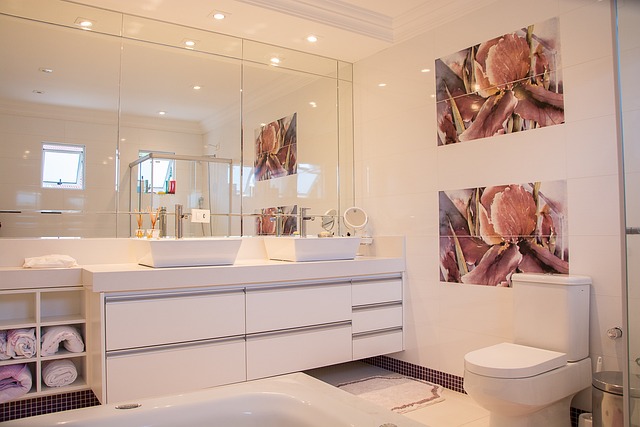Over a million people use wheelchairs in the UK. As the population increases, the number is expected to get bigger. When remodelling bathrooms, many people keep accessibility in mind since they wish to remain in their own homes. Therefore, many people consider accessible bathrooms to be an important component of a home.

It should not be challenging to design an accessible restroom, but numerous factors should be considered. When designing an accessible bathroom, aesthetics and style do not have to be sacrificed in favour of practicality. If possible, consider including accessibility when building a new home or remodelling an existing one instead of trying to incorporate it afterwards. Please continue reading to learn our top tips for how to build an accessible bathroom.
Bathroom Entrance
A typical wheelchair is 24-27″ wide, or roughly 600–690 mm. The bathroom door must be at least 32″ (815 mm) wide and ideally 36″ (915 mm) wide to accommodate a wheelchair. If the entrance is accessed from a hallway and you must turn the wheelchair to enter, the extra space makes it simple for a wheelchair to enter.
Additionally, it is better if the entryway has a fully flat floor so that the wheelchair may pass through without having to roll over a threshold or door sill.
Shower Handles
It is slippery and possibly dangerous in a shower, especially if you have mobility challenges. Support bars, also referred to as grab rails, are quite helpful. Support bars that are carefully positioned can greatly help to encourage autonomous movement and confidence-building.
Preplanning is crucial in this situation as well. Think about where these grab rails would be most effective based on your daily routine or the routine of the person for whom you are constructing an accessible restroom. In addition, the height and angle at which these bars should be positioned should be carefully considered.
They should be mounted 36 inches high on the back wall and 42 inches high on the sides of the toilet. The ADA doesn’t specify where grab bars should go in a shower or bathtub, so that you can put them anywhere.
Walk-In Shower
There are accessible options if a bath is what you would prefer to take instead of a shower. The most ideal of these are ones having a lower entry-level, which means that the user won’t have to exert much effort to get into the bath.
A walk-in bath is a more common choice that is simple to use and an excellent option for people who require assistance going in and out of the bath or washing their hands.
An ordinary bathtub is an alternative. However, verifying the exact measurements is crucial to ensure that the user’s accessibility equipment, such as any lifts, hoists, or chairs, can fit. In addition, bars and anti-slip mats should be incorporated, much like with a shower, to make using the bath simpler and safer. You can find a bathroom fitter to help you find the right materials.
Shower Chair
If you have trouble standing for any length, grab rails and shower seats are a must. Shower seats are also an excellent option for wheelchair users.
There are many different shower seats. Some have wheels to be used in a wet room and numerous showers, while others are folded up and stored away when not in use if you have roommates.
Easy-To-Reach Sink Area
Choose a design with a tilt or nothing underneath the sink to enable a wheelchair user to roll right up to the sink. An alternative option is a pedestal sink. Consider installing a long, single handle on the sink tap to make it simpler to turn on the water.
A slanted mirror fractionally angled down above the sink makes it easier for wheelchair users to view themselves. And instead of placing a lower medicine cabinet in an inaccessible spot, such as under the sink, try using lower drawers for storage instead.
Additional Room Near the Toilet
It is advised to allow space on one side of the toilet so that a wheelchair can be moved close by and for individuals who need assistance with transfers. Grabbing bars near the bathroom is also beneficial.
A bidet with a “comfort height” (higher) toilet may make using one easier. Finally, think about where these devices’ flush controls are. Ensure that they are in a convenient area for the user.
Temperature Control
It makes sense that digitally controlled showers are gaining popularity. Even before you enter the shower, these smart ones guarantee the ideal temperature.
The other end of the bathroom can accommodate the installation of those equipped with Bluetooth or wireless communication, many of which can be placed up to 10 metres away. A cold tap turned on elsewhere in the house would no longer be a nice experience for the shower user because they can regulate the temperature instead!
Slip-Resistant
Even when used properly, shower enclosures can be harmful, but people with trouble moving around are frequently more at risk. Showers should have flooring or tiles that provide good traction to reduce the danger of trips and falls.
Shower mats are a wonderful substitute, but the correct height should be considered if you use a wheelchair in the shower area.
Storage
Always position shelves, hanging shower caddies, or wall-mounted storage at the right height for the shower. Due to temperature variations and constant moisture, it’s also crucial to ensure these are securely fastened to the wall and appropriate for use in showers. In addition, some people would rather install a wash dispenser to deal with the issue of needing a place to store toiletries.
Bath
If the user can bathe independently, they might choose a height-adjustable or “walk-in” model. The former can be used like a regular bath, but it can also be lowered to make getting in and out easier. A walk-in bath can include a seat as an integral part and eliminate the problem of stepping up high to enter the bath.



